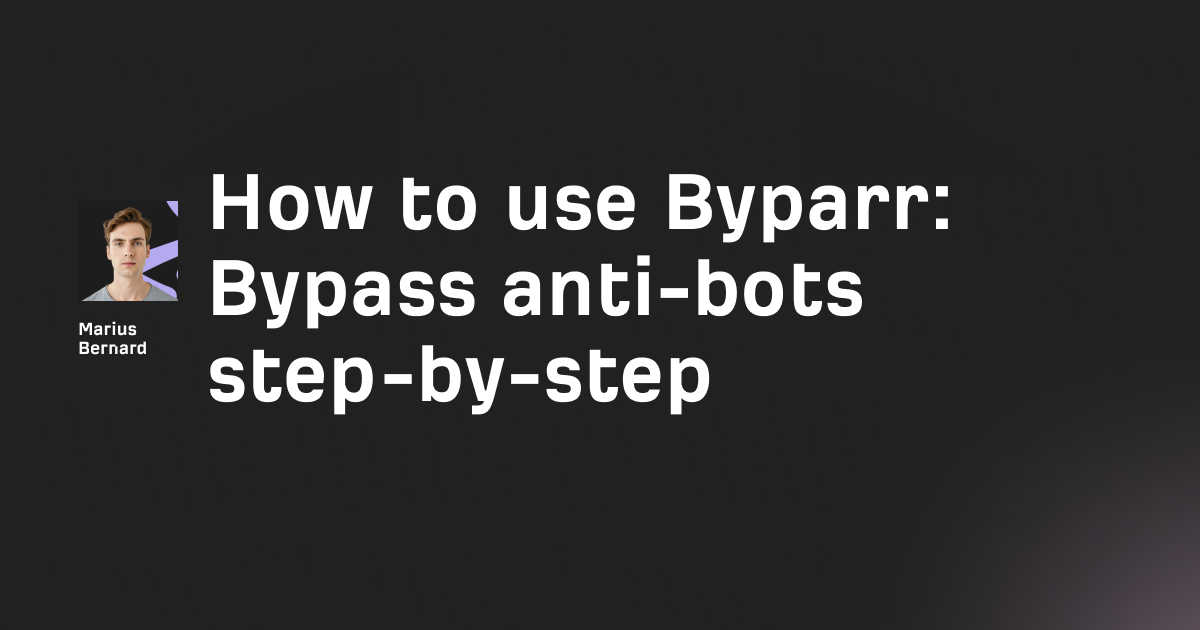Getting blocked by anti-bot systems when you're trying to scrape data or automate web tasks? You’re not alone. One minute you’re collecting valuable info, the next you’re staring at a CAPTCHA—or worse, you’re hit with an IP ban.
It’s frustrating, but it’s also fixable. I’ve spent years fine-tuning scraping techniques to stay one step ahead of evolving defenses. In this guide, I’ll walk you through how to bypass anti-bots in 2025, using the exact methods that helped my team scrape over 50 million product listings from protected e-commerce sites last year—with a 93% success rate.
Understanding Modern Anti-Bot Systems
Before we dive into anti-bot bypassing techniques, it’s crucial to understand the enemy.
Anti-bot defenses in 2025 have come a long way from simple IP bans and basic CAPTCHAs. Today’s systems analyze everything:
- Browser fingerprinting (canvas, WebGL, audio signals, fonts)
- Mouse movement and keystroke patterns
- Request timing and behavior patterns
- TLS/SSL handshake fingerprinting
- HTTP header consistency
- Browser automation detection markers
Heavy-hitters like Cloudflare, Akamai, DataDome, and PerimeterX now rely on machine learning to spot even sophisticated bots pretending to be humans.
Bottom line: If you’re not mimicking real human behavior down to the smallest detail, you’re going to get caught.
Step 1: Craft Human-Like Request Patterns
First up: request patterns. This is where most bots get busted.
Real humans don't open 50 pages in 10 seconds. Neither should your scraper.
Here's how to create natural browsing behavior:
import random
import time
# Instead of fixed delays
delay = random.uniform(3, 7) # Random delay between 3–7 seconds
time.sleep(delay)
Pro tips:
- Vary your navigation paths: Don't just scrape listings sequentially. Jump around like a human would.
- Session-based browsing: Mix homepage visits, category clicks, and product views within a session.
- Scale gradually: Start slow, ramp up scraping speed over days or weeks.
- Study real user behavior: Use analytics tools to mimic actual browsing habits on your target site.
Step 2: Manage Your Digital Fingerprint
In 2025, browser fingerprinting detection is ruthless. To survive, you need to mask your automation trail perfectly.
Here’s how:
// With Playwright
const browser = await playwright.chromium.launch({
headless: false, // Sometimes better than headless
args: [
'--disable-blink-features=AutomationControlled',
'--window-size=1920,1080'
]
});
Actionable tactics:
- Use real browsers: Playwright and Puppeteer (with stealth plugins) help avoid detection.
- Randomize fingerprints: Rotate canvas fingerprints, WebGL info, screen size, timezone, and more.
- Keep headers consistent: Match your User-Agent, Accept-Language, etc. throughout a session.
- Mimic human input: Implement non-linear, natural-looking mouse movements (use bezier curves).
Step 3: Implement Smart Proxy Rotation
IP rotation is still essential—but lazy rotation will get you banned fast.
Best practices:
def get_proxy(session_id, target_site):
# Assign consistent proxies to specific sessions
if session_id in session_proxy_map:
return session_proxy_map[session_id]
proxy = proxy_pool.get_optimal_proxy(
location=target_site.preferred_location,
isp=target_site.preferred_isp,
previous_success_rate=0.9
)
session_proxy_map[session_id] = proxy
return proxy
- Use residential proxies: Datacenter IPs are easier to block.
- Maintain geo-consistency: Stick to a region throughout a session.
- Monitor proxy performance: Track bans, success rates, and rotate smartly.
Step 4: Handle CAPTCHAs Effectively
CAPTCHAs aren't going anywhere. In fact, they're tougher than ever in 2025.
Here’s what works:
- Detect CAPTCHA types: Image, checkbox, invisible reCAPTCHA v3—identify them early.
- Use solving services: 2Captcha, Anti-Captcha, and similar tools now support nearly every format.
- Hybrid human-automation: Flag tough CAPTCHAs for manual solving if automated attempts fail.
- Custom solvers for scale: If you're solving thousands daily, train your own ML models.
Step 5: Navigate JavaScript Challenges
JavaScript challenges (like Cloudflare’s) are designed to detect non-browser traffic. Here’s how to survive:
// Override the Date to prevent timing analysis
const originalDate = Date;
Date = function() {
const date = new originalDate();
if (arguments.length === 0) {
return new originalDate(date.getTime() + Math.random() * 100);
}
return new originalDate(...arguments);
};
What you need to do:
- Run real browsers: Headless Chrome, Playwright, or Firefox with the right setup.
- Hook JS functions: Override fingerprinting scripts where needed.
- Wait for challenge completion: Don’t rush requests. Ensure the browser clears the challenge first.
Common Mistakes to Avoid
Scrapers fail because they ignore little details that matter big-time in 2025.
Avoid these:
- Ignoring mobile: Many sites have stronger mobile bot defenses. Always test both desktop and mobile modes.
- Using outdated tactics: What worked in 2023 probably won't work now.
- Skipping stealth checks: If your browser reveals it's automated (like having
webdriver=true), you're busted. - Cloning behavior patterns: 100 bots acting exactly the same? Instant detection.
- Forcing volume over finesse: Sometimes, respecting rate limits is smarter than brute-forcing.
Looking Ahead: The Future of Anti-Bot Bypassing
Things are moving fast. Here’s what’s coming:
- AI-driven browsing bots: ML models will mimic human behavior even better.
- Zero-interaction scraping: New techniques will gather data without triggering anti-bot defenses.
- Distributed human-assisted scraping: Networks of real browsers and real users collaborating.
At the end of the day, subtlety always wins. The best way to scrape in 2025 and beyond is to blend in so well that anti-bot systems don’t even notice you exist.








